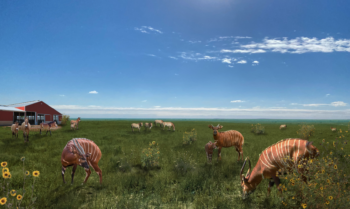March 1, 2024
Last Place(s) on Earth
New Asian Field Conservation Programs Protect Asian Elephants, Sumatran Orangutans + more
Indonesia’s Leuser Ecosystem is the last place on Earth where Critically Endangered Sumatran elephants, tigers, orangutans and rhinoceroses coexist in the wild. This remote UNESCO World Heritage site is home to countless fragile habitats and threatened species. Yet due to illegal farming and development, the entire area is in grave danger. That’s six million acres at risk.
When looking for global conservation work to support, Denver Zoo specifically seeks out situations like this one: places and projects where we can make a major impact with modest resources. The Leuser project is just one of several new Field Conservation efforts we’re launching this year throughout Asia. Read on to learn exactly what we’re doing, how—and why!

SUMATRA | Conservation Capacity Building
In the Leuser Ecosystem, Denver Zoo is excited to be working with Forum Konservasi Leuser (FKL), a passionate grass-roots NGO working to protect this unique area and its wildlife. Through this partnership, Denver Zoo will help FKL build a field station for research and poaching patrol, assist with the restoration of local habitats and much more.
We’ll also work in surrounding Sumatran communities to raise awareness about the long-term effects people have on these fragile ecosystems—with a focus on helping local people secure livelihoods with lower environmental impact. And here at the Zoo, our Sumatran tiger and orangutan family are also raising awareness! By helping our guests form a connection with charismatic individuals like ChloJo and Siska, we can spread the word about the dire need to protect their relatives in the wild.
LAOS+ | Asian Elephant Research + Education
Once called Lan Xang, Land of a Million Elephants, Laos was home to one of the largest elephant populations in Southeast Asia. But today, habitat loss, human-elephant conflict and the illegal wildlife trade have taken a devastating toll. Only about 400 wild elephants remain in the entire country, with the largest group found in Nakai-Nam Theun National Protected Area. More data is needed to address the unique threats to this important elephant population.
We’re proud to partner with Association Anoulak as they study Asian elephant population size, genetic diversity and social dynamics to inform Laos’ national Elephant Action Plan. We’re also working with the Elephant Conservation Center (ECC) to support the education of a Lao zoological veterinarian and lab technician. By providing access to highly specialized training not currently available at the National University of Laos, this project will benefit both the ECC and the Lao conservation community as a whole.
Denver Zoo has also become a Conservation Partner of the International Union for the Conservation of Nature’s Asian Elephant Specialist Group, a group of global experts dedicated to managing and protecting the species across the continent. And right here in Toyota Elephant Passage, Denver Zoo experts continue to study our beloved Asian elephant bachelor herd! Our ongoing findings are shared not only with our colleagues in the Association of Zoos and Aquariums—but with elephant conservation organizations all over the world.
LAOS | Northern White-Cheeked Gibbon Research
Thanks to an enriching habitat that encourages climbing and swinging, it’s easy for us to enjoy the amusing antics of Vinh and Briscoe, Denver Zoo’s northern white-cheeked gibbons. In the dense forests of their natural range, though, they’re incredibly difficult to see—and study! The Annamite Range, which straddles Laos and Vietnam, is the final haven for this Critically Endangered species. Here, we’ll expand our work with Association Anoulak to support a research program using cutting-edge acoustic recorders. Using sound to measure gibbon populations isn’t new, but this technology is much more accurate than the previous method: human hearing.

Walking the Walk—Into a Greener Future
Everything in nature is connected. That’s why our strategy follows the One Health model—a unified approach that connects humans, animals and ecosystems for the good of all. In addition to our work with wildlife and habitats, we must also work with local people to identify and address the root cause of each threat. The goal? A world in which humans and animals can share resources in a way that’s sustainable for both. There’s much work yet to be done. Our new programs in Asia are only part of the bigger picture...stay tuned for more announcements!
Subscribe
Be first to hear the latest animal updates, important stories and details about all the fun happening around Denver Zoo.
Tags
-
 April 15, 2024
April 15, 2024Good Luck, Chuck!
Good Luck, Chuck! Beloved Bachelor Relocating as Part of Asian Elephant Species Survival Plan In a heartfelt and collaborative…
-
 April 15, 2024
April 15, 2024African Impact
African Impact Two New African Field Conservation ProgramsAim to Protect Gorillas + Grey Crowned Cranes We're honored to provide…
-
 February 8, 2024
February 8, 2024Hope’s New Home
Hope's New Home HOW THE 600-ACRE LEMBKE FAMILY PRESERVE IS LAUNCHING THE NEXT GENERATION OF WILDLIFE CONSERVATION With…

